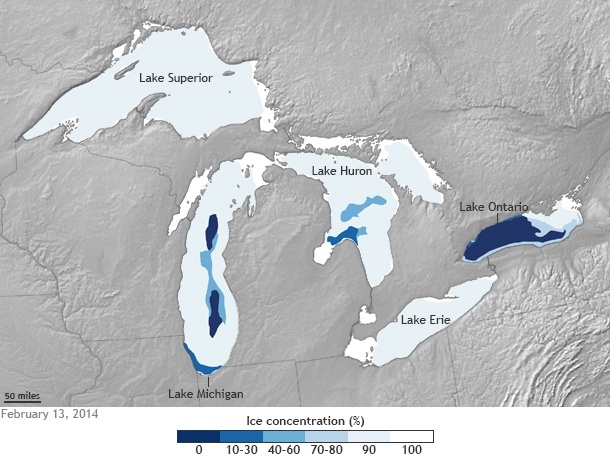Having weathered another snowstorm and dipped back into the deep freeze we can take solace that winter will end this month. At least we hope so.
Unfortunately if you live near one of the Great Lakes, winter will last longer than normal this year.
On February 24 Climate.gov reported that for the first time in 20 years the Great Lakes were more than 88% frozen with four lakes — Superior, Erie, Huron, and St. Clair — 90 to 100 percent ice covered. As you can see, Lake Ontario’s and Michigan’s open water kept the percentage down, but some of their open water is due to Coast Guard ice-breakers.
When I flew to Duluth, Minnesota on February 13 (the date of this map) I saw the ice first hand. As the map attests, the entire western end of Lake Erie was frozen solid from Sandusky to Point Pelee, so solid that there were snowmobile tracks from Port Clinton to Put-in-Bay and from Magee Marsh to Sister Island.
From the air I saw the southern patch of open water on Lake Michigan and the solid expanse of Lake Superior at Duluth where I later climbed the lake’s frozen heights. I didn’t stay in Duluth long enough to make the popular cross-ice trek from Meyers Beach in Bayfield, Wisconsin to the beautiful ice caves at the Apostle Islands National Lakeshore. Click here to see what I missed.
The very cold weather created the ice and ironically, the ice will delay the warmth of spring. In an interview with AccuWeather, Associate Professor Jay Austin of the Large Lakes Observatory in Duluth said of Lake Superior, “With all of this ice, all the sunlight that hits the surface of the lake is going to get bounced back out into space, so it’s going to take longer to get warmer this spring and summer. The lake is going to just start warming this year when it will start cooling off for next year.”
Aaaarg! A short summer? That’s just what Minnesotans don’t want to hear!
(map by NOAA Climate.gov, based on data provided by the U.S. Naval Ice Center. Click on the image to see the original and read more about the frozen lakes.)

I like the link to the ice cave photos. Thanks.